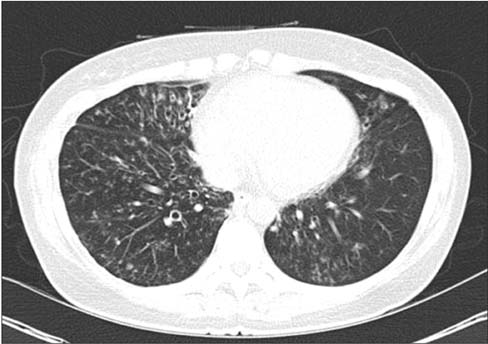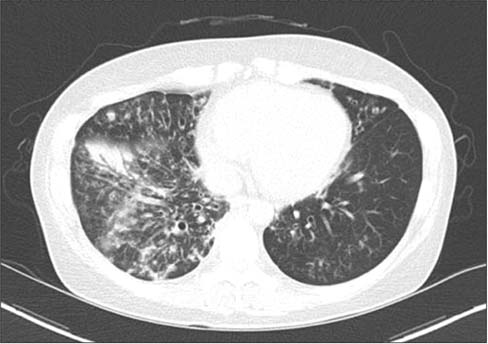Tuberc Respir Dis.
2014 Nov;77(5):227-229. 10.4046/trd.2014.77.5.227.
A Case of Segniliparus rugosus Pulmonary Infection in an Immunocompetent Patient with Non-cystic Fibrosis
- Affiliations
-
- 1Division of Pulmonary and Critical Care Medicine, Department of Internal Medicine, Konkuk University School of Medicine, Chungju, Korea.
- 2Department of Internal Medicine, Konkuk University Chungju Hospital, Konkuk University School of Medicine, Chungju, Korea.
- 3Department of Laboratory Medicine, Asan Medical Center, University of Ulsan College of Medicine, Seoul, Korea.
- 4Division of Pulmonary and Critical Care Medicine, Asan Medical Center, University of Ulsan College of Medicine, Seoul, Korea. heathcliff6800@hanmail.net
- KMID: 2050717
- DOI: http://doi.org/10.4046/trd.2014.77.5.227
Abstract
- Segniliparus species is a novel genus that is reported to be the new emerging respiratory pathogens. Here, we report a very rare case of S. rugosus pulmonary infection in an immunocompetent patient with non-cystic fibrosis. The organism was identified by 16S rRNA gene sequencing. The patient was successfully treated with antibiotics.
MeSH Terms
Figure
Reference
-
1. Butler WR, Floyd MM, Brown JM, Toney SR, Daneshvar MI, Cooksey RC, et al. Novel mycolic acid-containing bacteria in the family Segniliparaceae fam. nov., including the genus Segniliparus gen. nov., with descriptions of Segniliparus rotundus sp. nov. and Segniliparus rugosus sp. nov. Int J Syst Evol Microbiol. 2005; 55(Pt 4):1615–1624.2. Butler WR, Sheils CA, Brown-Elliott BA, Charles N, Colin AA, Gant MJ, et al. First isolations of Segniliparus rugosus from patients with cystic fibrosis. J Clin Microbiol. 2007; 45:3449–3452.3. Hansen T, Van-Kerckhof J, Jelfs P, Wainwright C, Ryan P, Coulter C. Segniliparus rugosus infection, Australia. Emerg Infect Dis. 2009; 15:611–613.4. Koh WJ, Choi GE, Lee SH, Park YK, Lee NY, Shin SJ. First case of Segniliparus rotundus pneumonia in a patient with bronchiectasis. J Clin Microbiol. 2011; 49:3403–3405.5. Choi SM, Kang HJ, Jeong YJ, Lim JH, Choe WS, Hwang SH, et al. First isolation of Segniliparus rugosus from a patient with radiologic features similar to non-tuberculous mycobacteriosis. Tuberc Respir Dis. 2012; 72:82–87.6. Relman DA. Universal bacterial 16sRNA amplification and sequencing. In : Persing DH, Smith TF, Tenover FC, White TJ, editors. Diagnostic molecular microbiology: principles and applications. Rochester: Mayo Foundation;2013. p. 489–495.7. Petti CA, Bosshard PP, Brandt ME, Clarridge JE, Feldblyum TV, Foxall P, et al. Interpretive criteria for identification of bacteria and fungi by DNA target sequencing. approved guideline. MM 18-A. Wayne: Clinical and Laboratory Standards Institute;2008.8. Griffith DE, Aksamit T, Brown-Elliott BA, Catanzaro A, Daley C, Gordin F, et al. An official ATS/IDSA statement: diagnosis, treatment, and prevention of nontuberculous mycobacterial diseases. Am J Respir Crit Care Med. 2007; 175:367–416.
- Full Text Links
- Actions
-
Cited
- CITED
-
- Close
- Share
- Similar articles
-
- First Isolation of Segniliparus rugosus from a Patient with Radiologic Features Similar to Non-Tuberculous Mycobacteriosis
- Cystic Fibrosis: Case Report
- A Case of Pulmonary and Endobronchial Mycobacterium avium Infection Presenting as an Acute Pneumonia in an Immunocompetent Patient
- Cystic Change in Pulmonary Tuberculosis in an Immunocompetent Adult: A Case Report
- Infection of Thyroid Cyst Occurring 1 Month after Fine-Needle Aspiration in an Immunocompetent Patient




